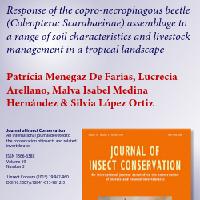Resumen
-
Understanding changes in copro-necrophagous beetle diversity related to characteristics of habitat and soil associated with livestock management systems can provide a tool for the conservation of edaphic fauna and improved use of natural resources. We evaluated changes in species diversity and assemblage structure in copro-necrophagous beetles under different livestock management systems in an anthropized tropical dry forest landscape in Mexico. We used a standard sampling protocol to capture copro-necrophagous beetles in three livestock management systems: silvopastoral systems with Guazuma ulmifolia Lam. (SPS) associated with grasses, treeless pastures (monocultures) and managed tree fallows of tropical dry forest with livestock. We characterized the habitat structure, management practices and physico-chemical parameters of the soil in each system. We recorded a total of 1423 specimens belonging to 15 species. The results show a greater beetle species richness in the SPS with G. ulmifolia, which declines with reduced site complexity and soil quality and increased management practice intensity. There was a positive relationship between beetle species abundance and the soil physico-chemical characteristics such as moisture and nutrient content, as well as with the density of plants. A negative effect of management practices (use of insecticides, anti-parasite treatments and burning) was observed on beetle abundance; when the analyzed variables were related to each individual species, only four species responded to differences in levels of nitrogen and magnesium, as well as to the management practice and density of plants. Systems where perennial woody plants (trees and/or shrubs) interact with traditional components (animals and herbaceous forage plants) under integrated management can provide favorable conditions for the maintenance of a relatively high diversity of beetle species as well as a refuge for species with different habitat requirements.
